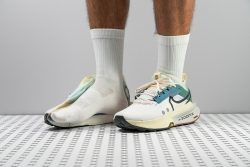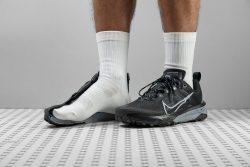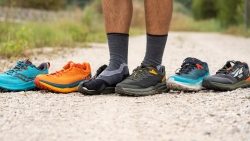7 Best Nike Trail Running Shoes in 2025
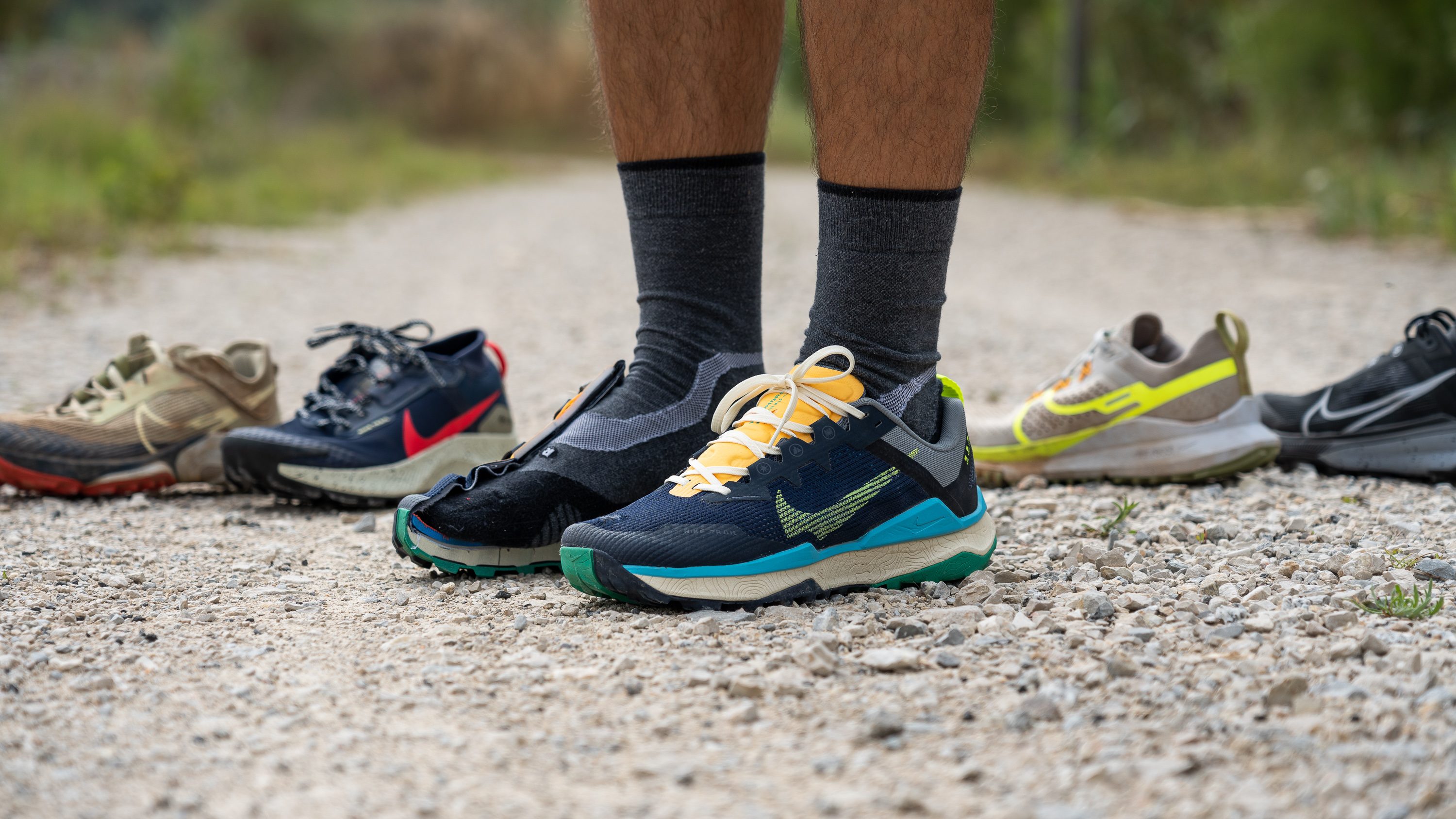
We buy shoes ourselves. We earn commissions when you buy through us, at no extra cost. Why trust us
Nike is a household name in the running world. Although it’s better known for its road running shoes, Nike doesn’t cut corners when it comes to trail shoes. They’re sturdy, traction-ready, stable, and responsive, helping you blaze through the trails with no sweat.
There’s so much hype over Nike trail running shoes, but we don't let the hype and marketing influence us. We tested Nike shoes ourselves and ended up picking the best models in different categories.
We ran in these shoes and we tested them in our independent lab. What you see here is the cumulative result.
How we test Nike trail running shoes
To be able to deliver objective reviews with straightforward pros and cons of Nike trail running shoes, we follow these steps:
- We buy all shoes with our own money to prevent biased reviews.
- We do high-mileage runs in each shoe and test them on trails, wet and dry, uphill and downhill, rocky and muddy.
- We cut each shoe first into half, then into pieces. We do this to spot all the techs and details inside the shoes. Also, we measure their 20 different parameters including traction, lug thickness, toebox durability, breathability, shock absorption, etc.
Best Nike trail running shoes overall
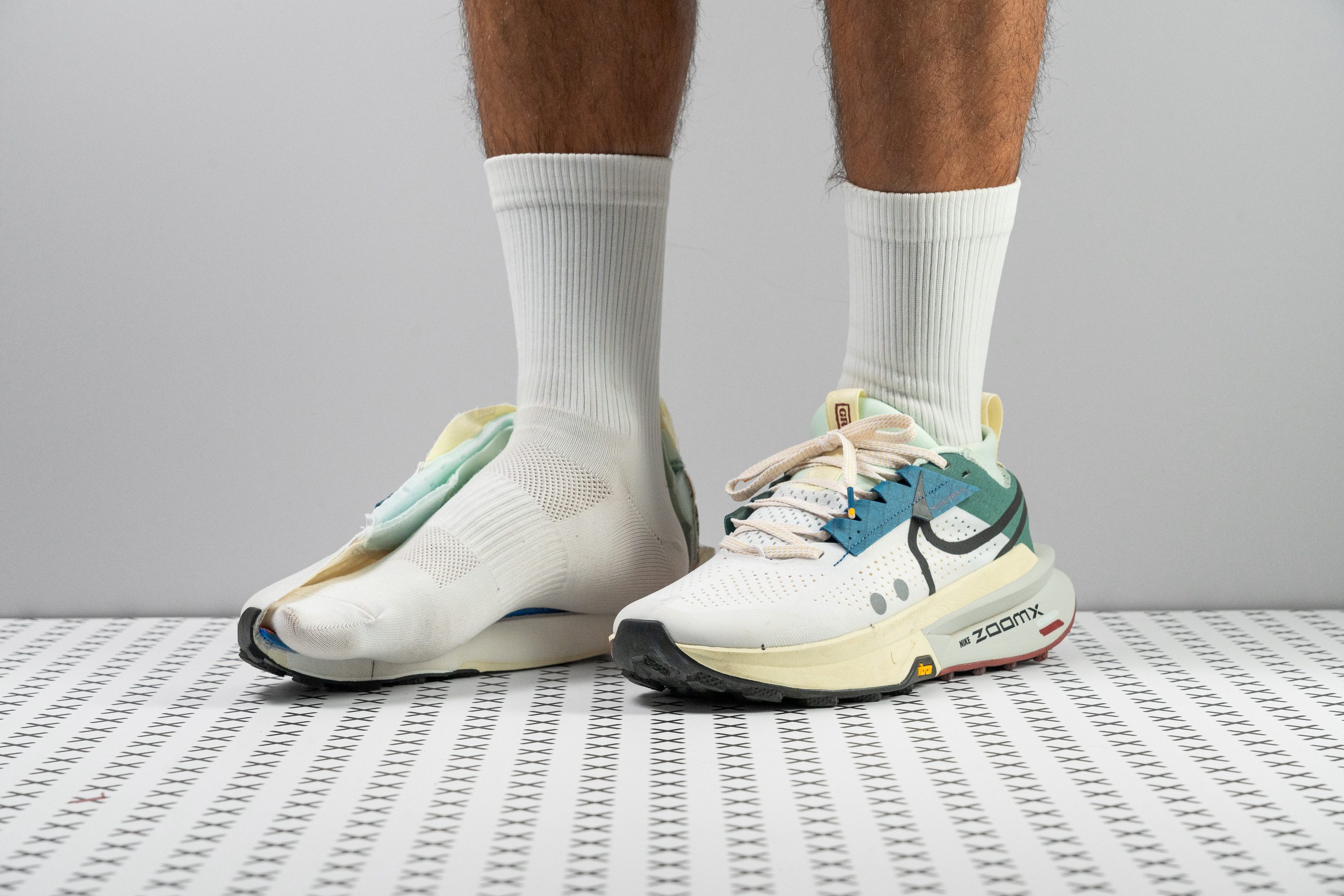
























































What makes it the best?
Make way for the best Nike trail running shoe we’ve ever tried and lab-tested: the Zegama 2. It holds the premium comfort of road running shoes through the energetic ZoomX midsole while serving the protection and traction needed to conquer various terrains through its all-around robustness and Vibram Megagrip outsole.
No matter how long we ran, the experience felt effortless thanks to the leg-saving ZoomX superfoam. Featuring a 30.3/26.3 mm stack height that's 36.1% softer than the average trail shoe, it was easy to chase the miles. Combined with its rocker geometry, every stride felt energized, making the trail experience more dynamic.
We tested the world-renowned Vibram Megagrip rubber by running through dry and wet surfaces, and we had no issues with grip. Zegama 2 boasts 4.0 mm-deep Traction Lugs that keep us in control. Our lab test also confirms its exceptional durability, with only 0.8 mm of damage against our rigorous Dremel.
Additionally, Zegama 2 continues to impress us with exceptional ratings in our abrasion tests. From its breathable upper to the heel, it earned above-average scores of 4/5 and 5/5, proving its resilience.
However, weighing in at a hefty 10.7 oz (302g), the Zegama 2 may lose its appeal to those seeking a barely-there feel or a competitive pace.
Pros
- More ZoomX bouncy foam!
- Vibram Megagrip outsole
- Spacious upper
- Exceptional durability
- Superb wet condition traction
- Ideal for midfoot and forefoot strikers
- Ready for long-distance running
- Suitable for hiking too
Cons
- Could be lighter
- Not ideal for heel strikers
Best Nike road-to-trail running shoes
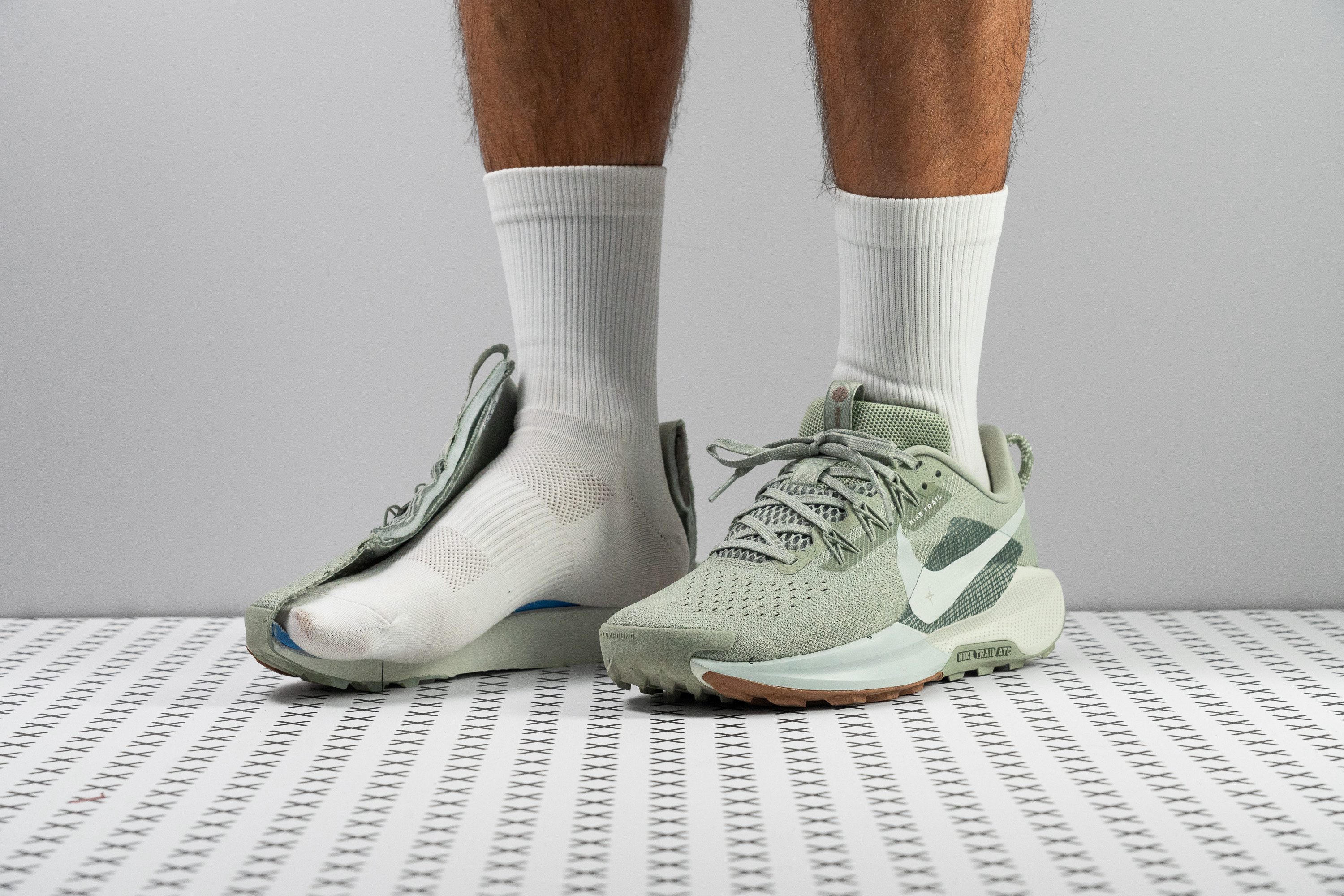






















































What makes it the best?
Our shifts from the mountains to the streets were made effortless by the Pegasus Trail 5. It's responsive, versatile, and adapts to various surfaces well. From its tough build to its grippy base and protective midsole, the PT5 is our best hybrid Nike trail running shoe.
The ReactX midsole energized our strides, proven by our lab test with impressive 57.6% and 58.7% rebound scores in the heel and forefoot, respectively. We could endure long miles at a steady pace because the midsole also features a rocker that keeps the ride smooth.
The All-Terrain Compound outsole, measuring a solid 87.9 HC on our durometer, proved its toughness during outdoor testing with barely any damage. We found the 3.2 mm lugs to have the perfect depth for providing a secure grip without feeling too bulky on the road.
The upper proved high-quality as it bravely fought against our Dremel, emerging as the victor with its perfect 5/5 toebox durability rating. Sharp rocks and protruding roots won't affect its integrity, keeping our feet safe. However, the dense upper sacrifices ventilation, receiving a disappointing 2/5 rating. As such, we advise against using this pair in warmer climates.
Pros
- Fully gusseted tongue
- Reflective elements
- Durable upper construction
- New rockered sole
- Great for heel strikers
- Reasonably priced
- All-around comfort
Cons
- Weight increase
- Possibly too plush for trails
- Still lacks traction
Best Nike trail running shoes for race
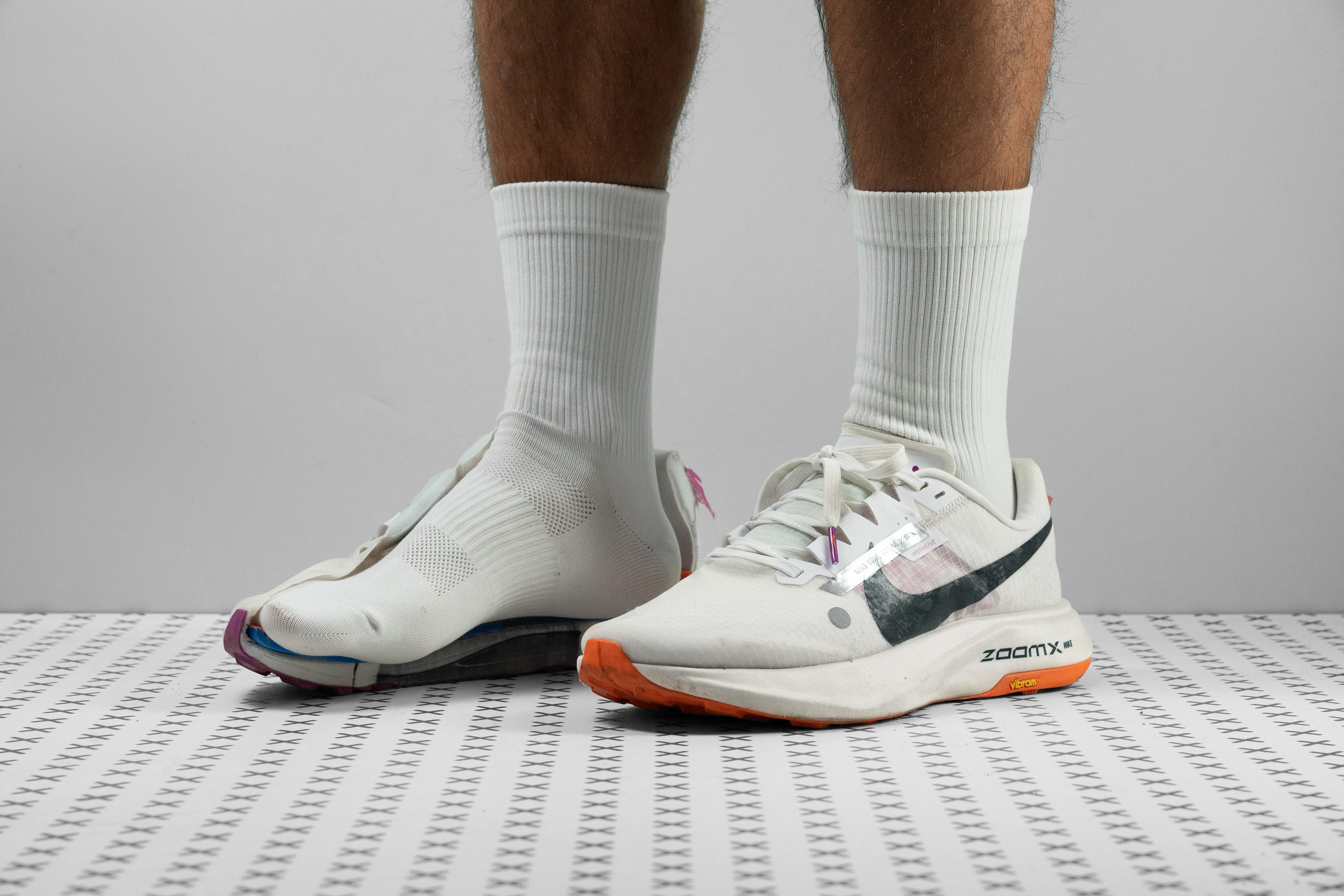



















































What makes it the best?
Ultrafly delivers a Vaporfly experience for the trails with its world-class energy return and plush platform. It surprisingly offers one of the most stable rides! After testing out and cutting open Nike’s best trail runners, we found Ultrafly to be the best racer. It’s a high-performance shoe that offers the best of both worlds — comfort and speed at any distance.
Featuring a full-length carbon plate that’s rare in trail shoes, Ultrafly feels insanely rigid and responsive. Upon checking with our bend test, it stands 31.5% stiffer than average. Underfoot is a robust Vibram outsole lined with 3.0 mm lugs to enhance grip. We found it performs best on easy trails and fast runs.
Despite the stiffness, it's ultra-soft to the touch. It stands as one of the thickest models, particularly in the 36.3 mm heel. Ultrafly stands out with its unusual cloud-like experience, which our durometer confirms is 9.8 HA — 63.7% plusher than average! The ZoomX midsole offers an exceptionally bouncy ride, making long miles effortless.
Ultrafly gives an unexpectedly stable ride, driven by the carbon plate and impressively wide midsole that inhibits awkward foot movements. This trail shoe offers generous room for high-volume feet and ensures steady landings.
With its focus on comfort and stability, Ultrafly feels extra heavy. Weighing 10.6 oz (299g), it’s beefier than the 10.4 oz (296g) average of trail shoes.
Pros
- Optimized for trail races
- Accommodates wide feet with ease
- Full-length, responsive Pebax midsole
- Equipped with a Vibram Megagrip outsole
- Ideal for heel strikers
- Offers outstanding comfort
- Remarkably stable
- Suitable for 100-mile races
Cons
- The Vaporweave upper could be more durable and breathable
- Heavier than expected even for a trail racing shoe
- The $260 price tag might be steep for some
- Limited toebox height
Best Nike trail running shoes for speed
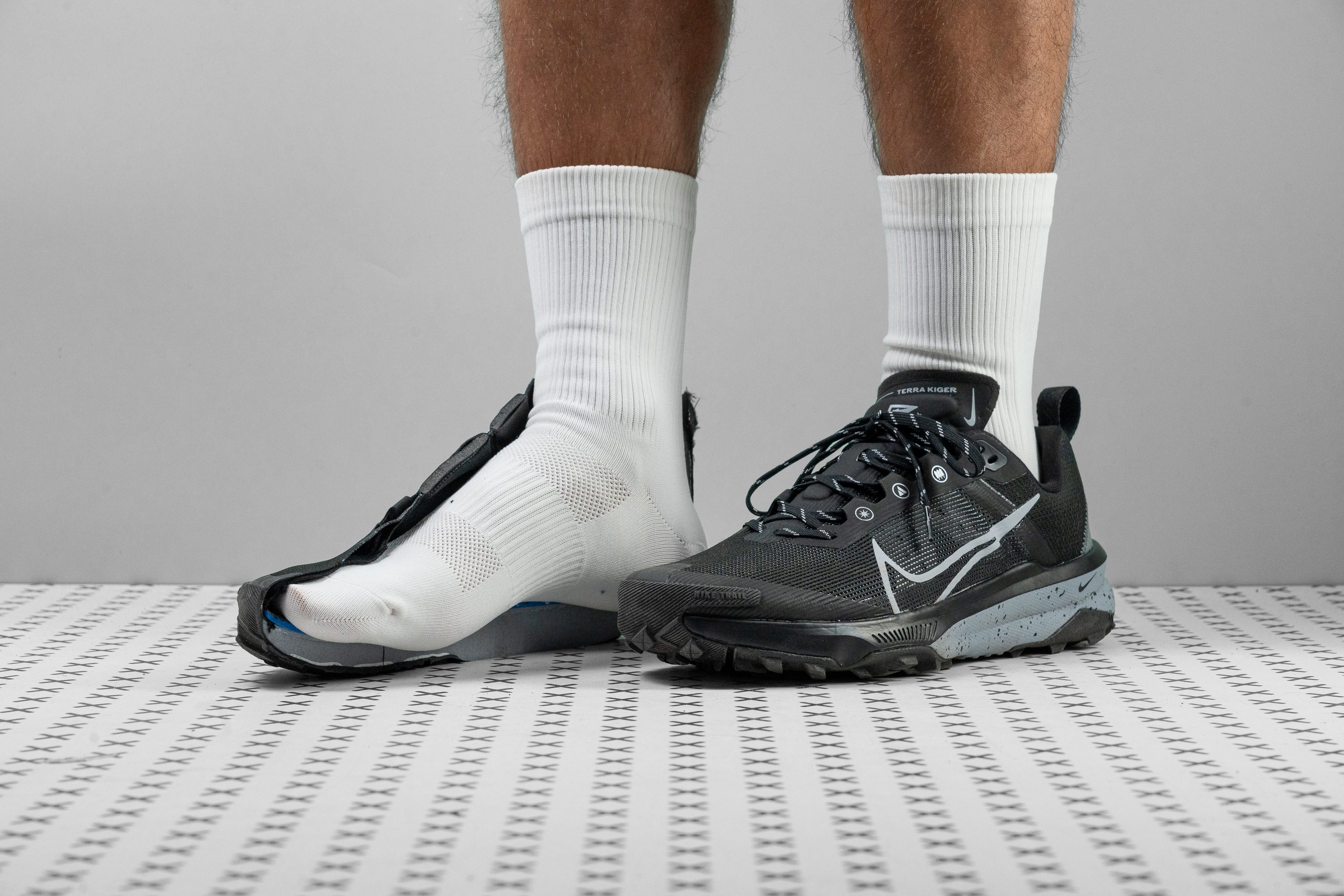






































What makes it the best?
Nimble and lightweight, yet offers a propulsive feel and amazing traction: the Nike Terra Kiger 9 holds all of these powerful features packed in a featherlight package. If speed on the trails is the priority, whether in training or races, this shoe delivers.
The Nike Terra Kiger 9 feels so light that it's almost cloud-like. It weighs 288g (10.16 oz), which is clearly below the average weight of trail running shoes at 296g (10,44 oz). When we wore these shoes, we felt like we could fly on the trails.
The react foam on the Terra Kiger 9 feels very responsive but also protective. Measuring 17.3HA on the durometer test, it is 37.32% softer than the average of trail running shoes. This provided us with a heavenly blend of energy and comfort.
The outsole on the Terra Kiger 9 is grippy on most terrains and we were able to cruise smoothly on rocks, loose ground, light mud, and even trails. The 4.4 mm lug depth is actually 25.7% more than the average, giving it superior flexibility for running on more technical terrain.
Although it has an excellent grip on dry surfaces, its grip on wet terrain is slightly amiss. It is recommended for runners to look elsewhere if grippier shoes are a priority.
Pros
- Bouncy and durable React foam
- Excellent grip on dry terrain
- Built-like-a-tank upper
- Adequate cushioning for long runs
- Fantastic choice for wide feet
- No heel slippage
- Light and agile
- Remarkable value at $150
- Outstanding choice for forefoot strikers
Cons
- Subpar grip performance on wet terrain
- Could be more stable
Nike running shoes with the best shock absorption
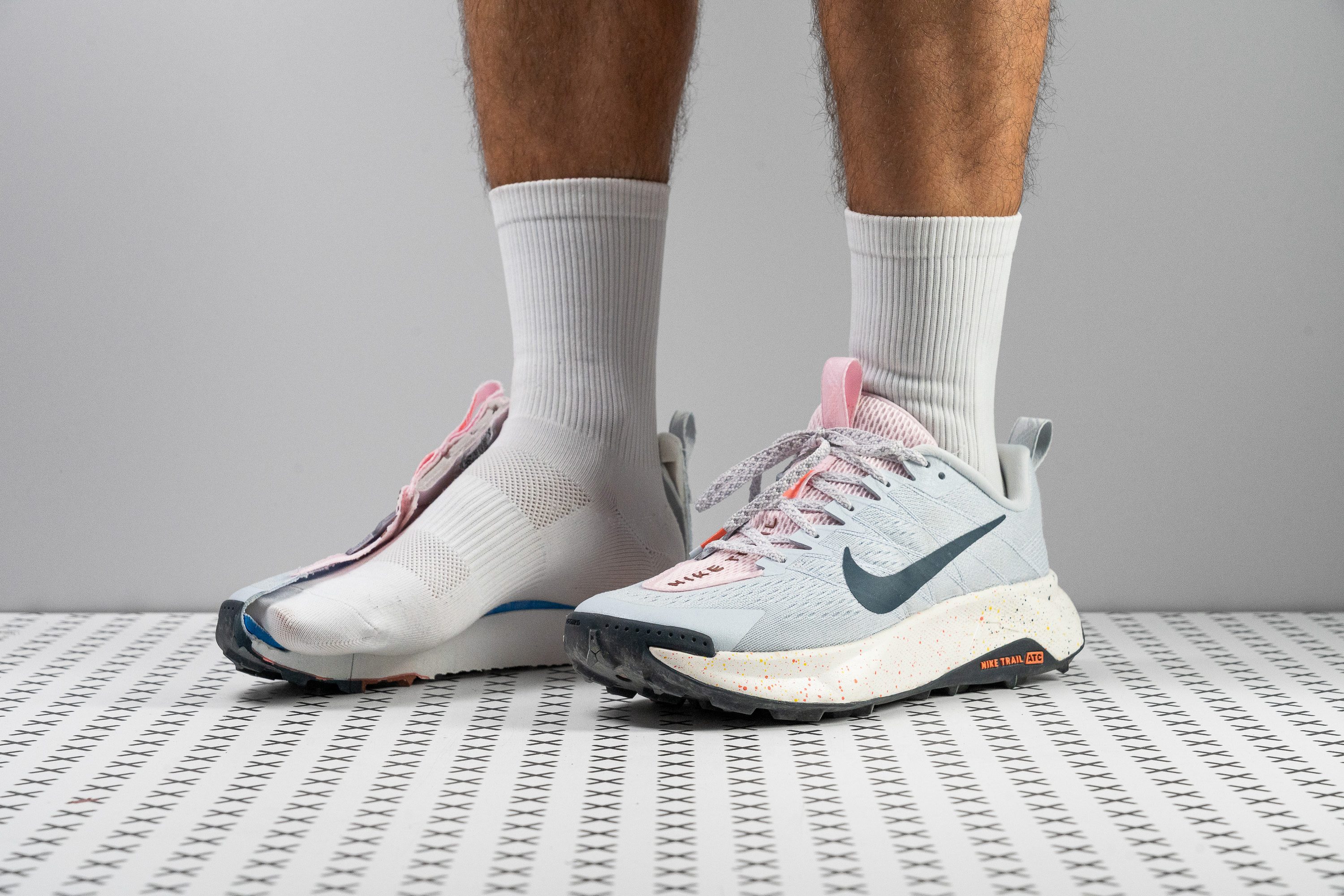










































What makes it the best?
During our mountain runs in the Nike Wildhorse 10, we can’t help but think that it goes big on cushioning. Besides its plush sensation, it feels responsive, which makes us cruise through the miles. Boosted with rugged features, it ensures our safety on diverse terrains. From its rock plate to its protective midsole, the Wildhorse 10 is the Nike trail running shoe with the best shock absorption.
The ReactX foam delivers exceptional comfort and responsiveness. With a 144 SA result in our shock absorption test, it offers 20.0% more impact protection than average. We also recorded a nice 61.3% energy return in the heel, together with a steep 10.9 mm drop, enhancing more natural heel-to-toe transitions.
Measuring the shoe’s stack, we got above-average figures of 38.3/27.4 mm. We’ve got a huge chunk of foam elevating us from the ground. As if that wasn’t enough, the forefoot features the Rock Shield plate, which definitely didn’t make us feel a thing. Whether it was sharp rocks or protruding roots, our feet remained safe.
Unfortunately, the Wildhorse 10 feels quite stiff and takes more effort to maneuver than its previous versions. Those seeking ultra-light agility should skip this pair.
Pros
- Cushion-packed midsole
- Modernized upper
- Ideal for heel strikers
- Better build quality
- Bold new look with better finish
- Versatile
- Improved energy return
- Forefoot rock plate
Cons
- Still too heavy
- Mesh upper is fragile
- Brutal price hike
- Less agile than predecessors
Best waterproof Nike trail running shoes

















































What makes it the best?
The Nike Pegasus Trail 5 GTX not only offers waterproof protection but also amazing agility and incredible bounciness in a lightweight package. It’s an all-around performer in our lab tests and runs, making it our top waterproof Nike trail running shoe.
Other than the Gore-Tex membrane, this Peg has a dense mesh that effectively keeps water out. In our breathability test, not a wisp of smoke escaped, earning a 1/5 score. This rating means it also traps body heat and keeps cold air out.
Agility is the name of the game. While most waterproof versions gain weight vs. their non-GTX counterparts, the Peg Trail 5 GTX shocked us with its 9.9 oz (281g) build! For reference, the Peg Trail 5 weighs 10.1 oz (286g)! It also feels easy to maneuver, emerging 29.4% more flexible than average in our bend test.
The Peg also has a lively and comfortable ReactX midsole that allows us to run without counting the miles. Its 23.4% softer-than-average cushion protects our feet during trail adventures. Though it feels soft, it still delivers a peppy ride.
While comfortable, the humble stack lacks the extra foam to protect our legs for longer mileage, especially in its 23.8 mm forefoot. Those seeking plush comfort can check alternatives.
Pros
- High-quality Gore-Tex membrane
- Lighter than the Pegasus Trail 5!
- Fantastic for midfoot strikers
- Doubles as a hiking and walking shoe
- Good ReactX midsole
- Amazing for winter
- Can handle all-day adventures
- Reasonable price hike
Cons
- Ankle instability for heel strikers
- Upper lacks padding
- Limited breathability
- Grip falls short on technical terrain
Best budget Nike trail running shoes
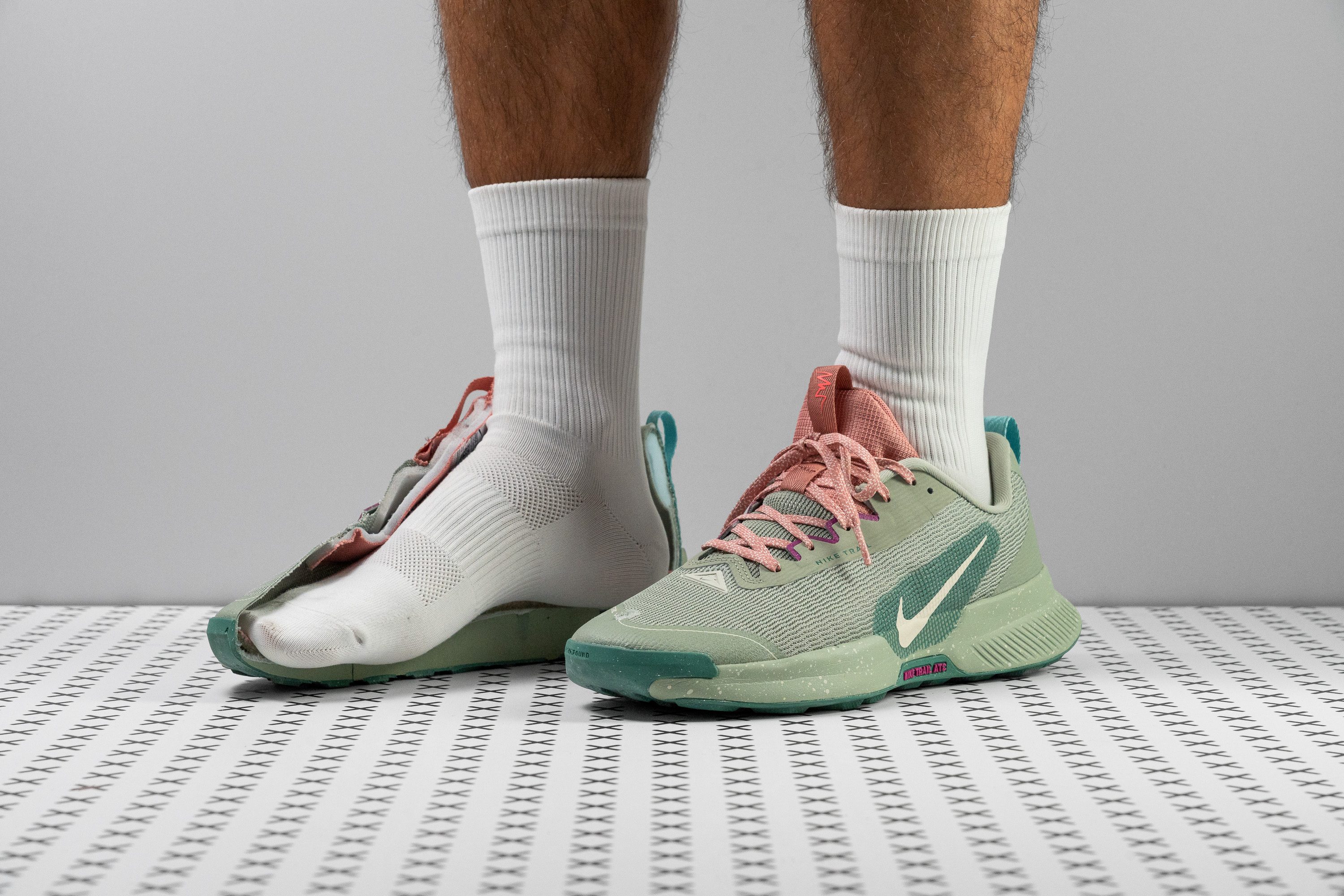




















































What makes it the best?
At a non-intimidating $90 price, Juniper Trail 3 is our best budget pick among Nike’s trail lineup. In our trail runs and lab tests, we found that it’s a great road-to-trail shoe that offers a natural and stable ride. Its flexible midsole enhances our agility and delivers the wear resistance needed to last many seasons.
While Nike trail shoes average $132, Juniper Trail 3 stands below the $100 mark. For the price, it doesn’t hold back on comfort. It weighs a light 10.2 oz (288g), boosting our agility. Adding to the pleasant experience is the unresisting midsole that allows us to adapt to uneven terrains easily. Our bend test confirms it’s 23.7% more flexible than average.
The balanced cushion and low stack enhance our stability, explaining why we have no awkward foot movements during testing. Our caliper reveals the stack is at 32.6/21.7 mm and measures 23.0 HA, aligned with our lab average.
After extensive mileage, the All-Terrain Compound looked fairly new. Our durometer backs this up with a high 87.0 HC measurement, while our Dremel proves its durability with only 0.8 mm damage.
We advise against using the Juniper Trail 3 in hot weather since its dense upper lacks ventilation, earning only a 2/5 rating in our smoke test.
Pros
- Wallet-friendly pricing
- Enhanced midsole cushioning
- Heel-striker optimized design
- Spacious toebox
- Closer than ever to the Peg Trail
- Upgraded midsole
- All-terrain versatility
- Reflective elements
- Good grip
Cons
- Reduced stack height compared to v2
- Not the best for forefoot strikers
- Limited breathability
Nike is no stranger to designing and manufacturing footwear with innovative footwear technologies. It’s no different with their lineup of trail running shoes.
Nike’s trail running shoes combine many of their tried and true running shoe technologies with extra features that prepare their shoes for the rough conditions you find on the trail.

Let’s have a look at some of the core components that make Nike trail running shoes so effective. And some proprietary Nike technologies you can expect to benefit from by purchasing Nike trail running shoes.
How to select the best Nike trail running shoe for you
With such a strong lineup of impressive trail runners, it’s tricky to delineate which shoe is best for you. Here are some things to think about that will help you make your decision.
Consider the terrain you enjoy
The trail running shoes you purchase should possess characteristics and features that lend themselves to the terrain you most often run on.
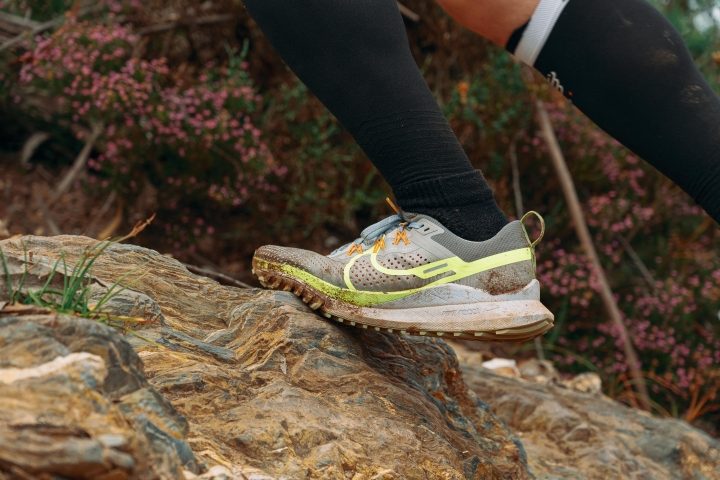
Think about it this way– trail running shoes are tools you can employ to accomplish the task of trail running. You want to employ the best tool for the job. For example, you wouldn’t use a crescent wrench to hammer in a nail.
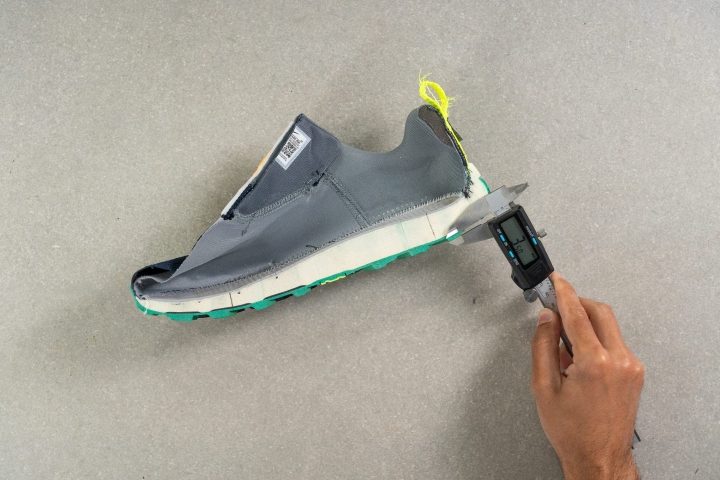
Nike shoes with shallower lugs are better for transitioning from road to trail. Example:
- Nike Pegasus Trail (3.4 mm lugs)
- Nike Wildhorse (3.5 mm lugs)
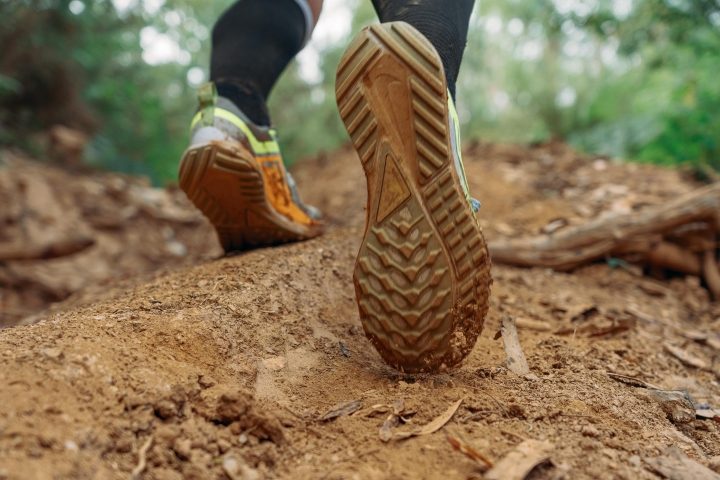
Trail shoes with deeper lugs are better for mud, slush, and other types of soft and loose terrain. Example:
- Nike Terra Kiger (4.4 mm)
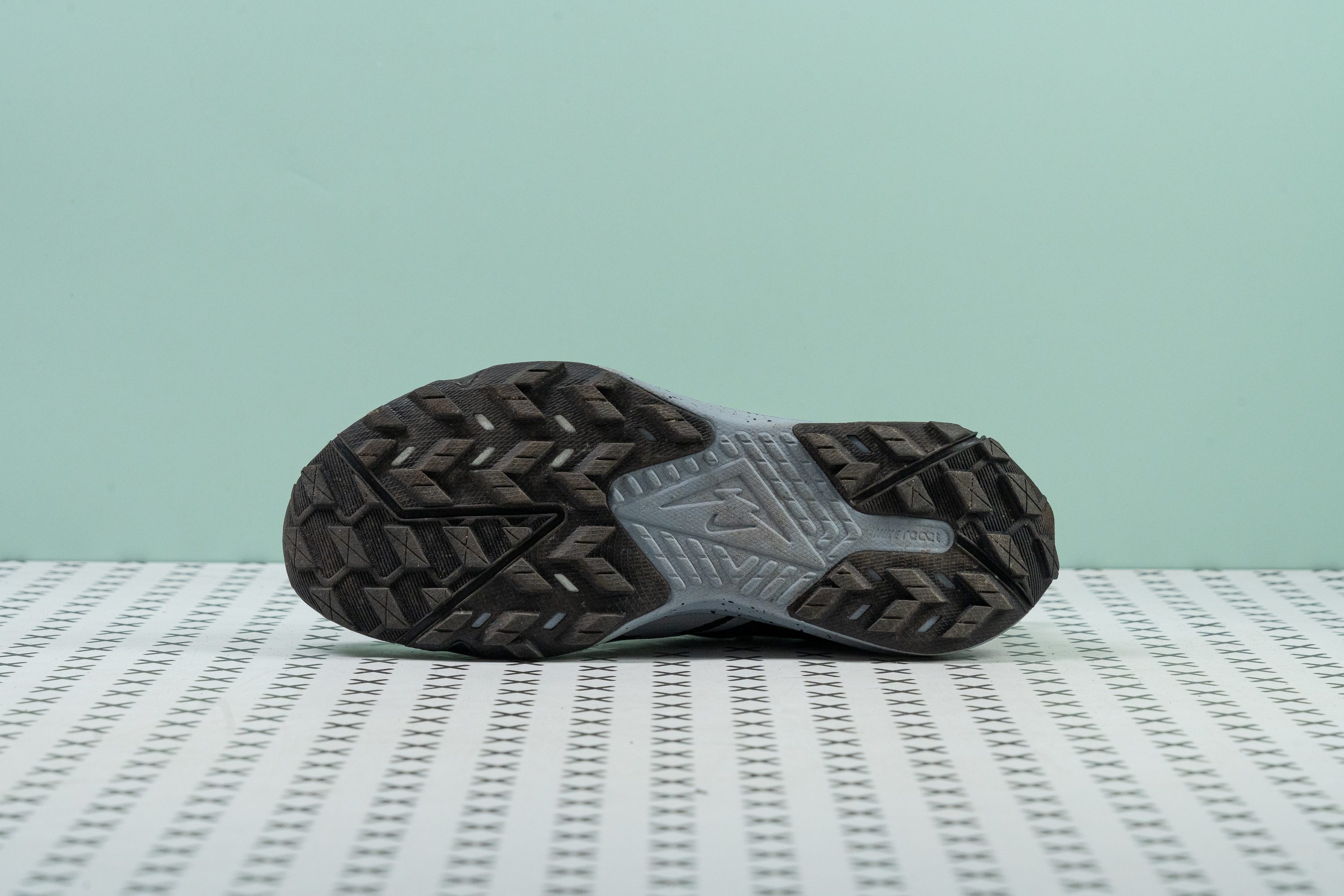
Think about the volume, intensity, and duration of your trail running
Volume is how often you go trail running. Intensity is how hard your trail running typically is. And duration is how long your trail runs can go for.
Do you prefer long runs in the backcountry? Do you want a shoe for casual runs nearby town? Do you run every week or every day?
Ideally, you want to select a Nike trail running shoe that can stand up to your typical routine. For example, if you cover longer distances (10K+) or have long stretches of road or hard-packed terrain, go for Nike shoes with more cushioning:
- Nike Pegasus Trail (heel stack: 35.5 mm)
- Nike Wildhorse (heel stack: 34.2 mm)
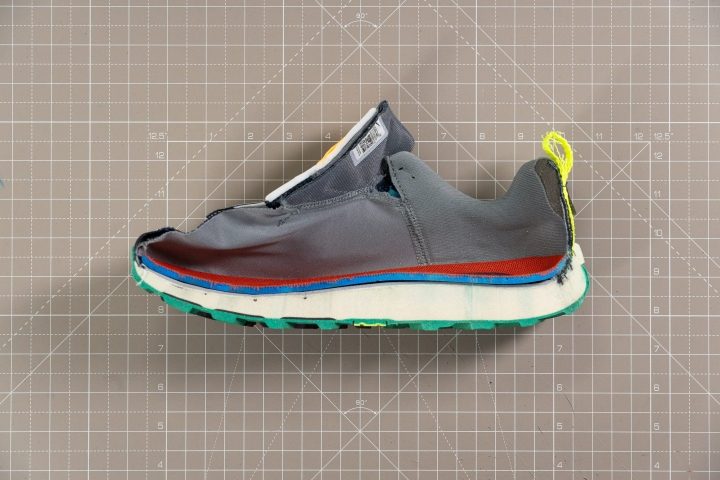
And if you go on shorter but want to feel speedier and more maneuverable on technical terrain, try:
- Nike Terra Kiger (heel stack: 30.1 mm)
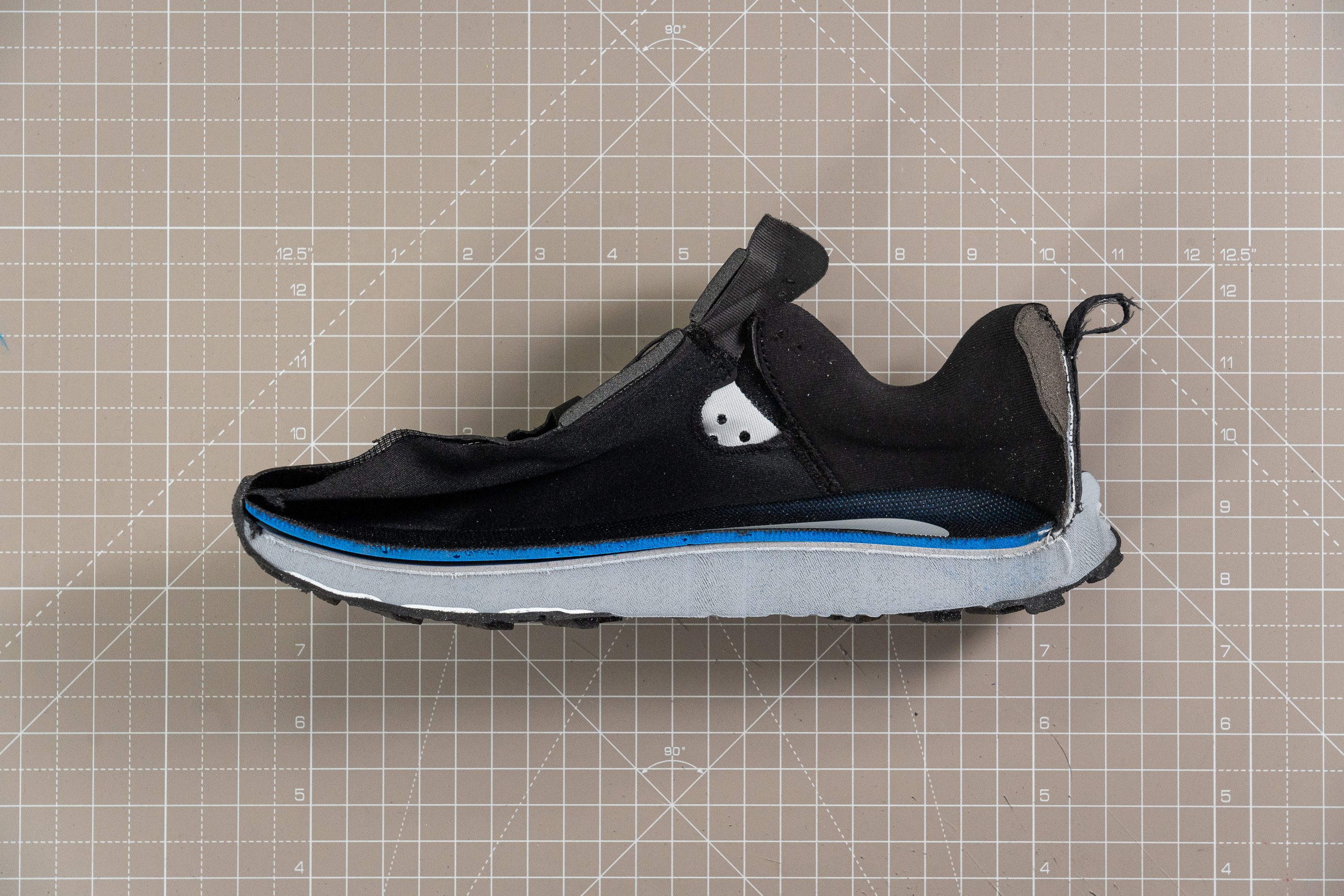
Consider if you need waterproofing
If you live in a geographic region that has consistent wet weather, you may need to invest in a pair of Nike trail running shoes that feature a GTX membrane.
On the other hand, if you live in a dry and arid region, you may not need GTX trail running shoes. In that case, you may be better off with a pair of Nike’s super breathable trail runners.
The difference in breathability is very apparent in our smoke-pumping machine test:
Waterproof GTX shoe vs. non-waterproof shoe
Think about versatility
Are you looking for a specialized purpose-built trail running shoe that you deploy for trail running missions? Or do you need a more versatile shoe that you can put on for various activities, including trail running, hiking, and maybe even running errands?
The Pegasus Trail is Nike's most versatile trail running shoe.
What makes Nike trail running shoes effective?
Lightweight materials are used in the upper
One of the most important characteristics of Nike trail running shoes is that they are lightweight. Nike accomplishes this by utilizing synthetic materials in the shoe’s upper. For example, many Nike trail running shoe designs incorporate mesh in the construction.
Uppers constructed with synthetic materials like mesh facilitate unprecedented breathability when compared to other materials like leather. Breathability is very important for trail running shoes because the more the shoes can breathe, the better your feet can ventilate and avoid overheating.
In addition, trail running shoes made with breathable materials dry quickly. That’s because synthetic materials hold onto less moisture in the first place. In addition, synthetic materials like mesh ventilate more effectively than heavier and thicker materials.
Therefore, when given the opportunity to dry, Nike trail running shoes will dry super fast after getting soaked in an afternoon thunderstorm or slipping in a creek.
The midsoles are made with EVA foam
Trail running is hard on your body, in particular your feet. That’s why Nike trail running shoes utilize ethylene vinyl acetate (EVA) foam in their midsoles. When it comes to dampening vibrations and absorbing shocks, EVA foam is the best in the business.
Plus, the material is lightweight and relatively durable. What’s not to love?
Of the Nike trail running shoes we reviewed, the Nike Wildhorse 8 had the softest cushioning. This makes the Wildhorse 8 ideal for long-distance trail running and ultra running.

The midsoles have integrated rock plates
Rock plates are super important for the effectiveness of trail running shoes. They are harder plastic (normally polyurethane) shields that are integrated into a shoe’s midsole.
The extra rigidity from the harder plastic adds stability and support to the shoe. But most importantly, they protect your feet from sharp objects on the trail, like rocks and roots.

One fallback of rock plates is that they can add some weight to the overall design of the shoe. However, unless you’re a gram-counting trail runner, the difference is negligible.
The outsoles are designed for offroad use
Another way that Nike trail running shoes stand out from the rest is with their outsole design.
The outsole of a trail running shoe is important because it’s the first point of contact between you and the trail. Its purpose is to provide you with traction as you move over varied terrain such as dirt, rocks, gravel, mud, grass, snow, and ice.
Trail running outsoles feature specially designed lug profiles and patterns. When compared to traditional running shoes, trail shoes have aggressive chevron-shaped and large lugs. In addition, wide lug spacing allows mud to clear out quickly from the tread.

Nike trail running shoes also rely on special rubber compounds for off-road usage. Typically, the rubber used in trail runners is thicker, harder, and more resistant to abrasion. That way, the outsole can remain durable and outlast the lifespan of the shoe.
Nike trail running technologies
Nike has been at the forefront of footwear technology since the very beginning. When it comes to their trail running shoes, it’s no different. Let’s take a look at some of the impressive technologies you can look forward to in Nike trail running shoes.
Nike React technology is super responsive
Nike React is one of Nike’s most responsive foam types. It’s 11% softer and offers 13% more energy return. Plus, it’s more durable and lightweight.
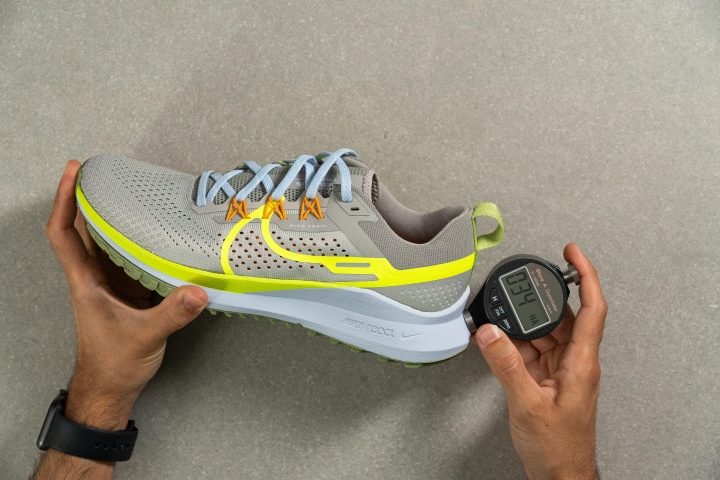
To achieve its unique characteristics, Nike combined multiple polymers– thermoplastic elastomers (TPE) and ethylene vinyl acetate (EVA).
ZoomX foam gives you the greatest possible energy return
ZoomX foam uses cutting edge technology to offer you the greatest possible energy return. The foam and the midsole’s shape literally help you turn the impact of your step into energy for your next stride.
Zoom X is Nike’s lightest foam type. And it offers 85% energy return– the greatest of any Nike foam.
Gore-Tex waterproof materials keep your feet dry
For trail runners who don’t want the threat of rain or river to slow them down, Nike has created some of the shoes in their trail running lineup with Gore-Tex.

Gore-Tex (GTX) is a high-performance material made from expanded polytetrafluoroethylene (ePTFE). Due to the unique qualities of ePTFE, GTX materials are water and windproof. Even better, GTX fabrics are still breathable and allow for ventilation.
Vibram rubber outsoles give you traction
For the first time, Nike has collaborated with Vibram to offer a trail running shoe that combines Nike’s innovative shoe technologies with Vibram’s tried and true rubber.
The Nike Ultralfy Trail features Vibram’s Litebase technology. Vibrams Litebase uses Vibram's award-winning traction lug technology and its Megagrip rubber compound.
Carbon Flyplate protects your feet
Nike’s Carbon Flyplate is a thin and rigid carbon fiber plate embedded in the shoe’s midsole. The Flyplate is featured in many different Nike shoes and is designed to provide support, minimize fatigue, ease pressure in your Achilles, and reduce slipping inside the shoe.
As an added bonus in Nike trail running shoes, the Carboon Flyplate also functions as a rock shield protecting the bottoms of your feet from aggressive impacts with sharp objects on the trail.
Vaporweave mesh allows your feet to breathe
Vaporweave is a proprietary Nike material used to construct the uppers of many of their running shoes, including some trail running shoes. The Vaporweave mesh is a mixture of thermoplastic polymers and nylon and is inspired by boat racing sails.
Due to its construction, it absorbs much less water than other Nike meshes. Plus, it’s super breathable, lightweight, and relatively durable.

